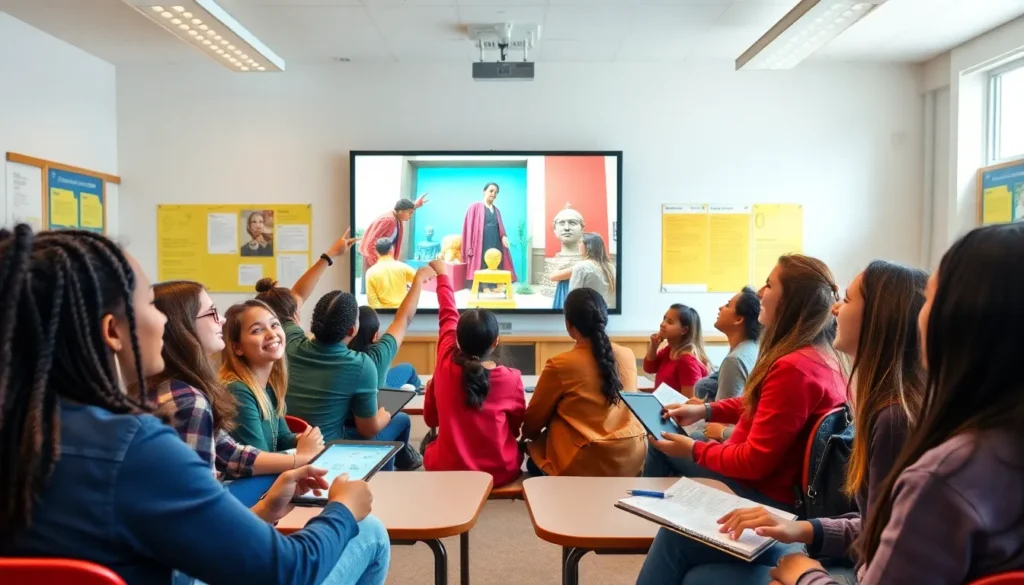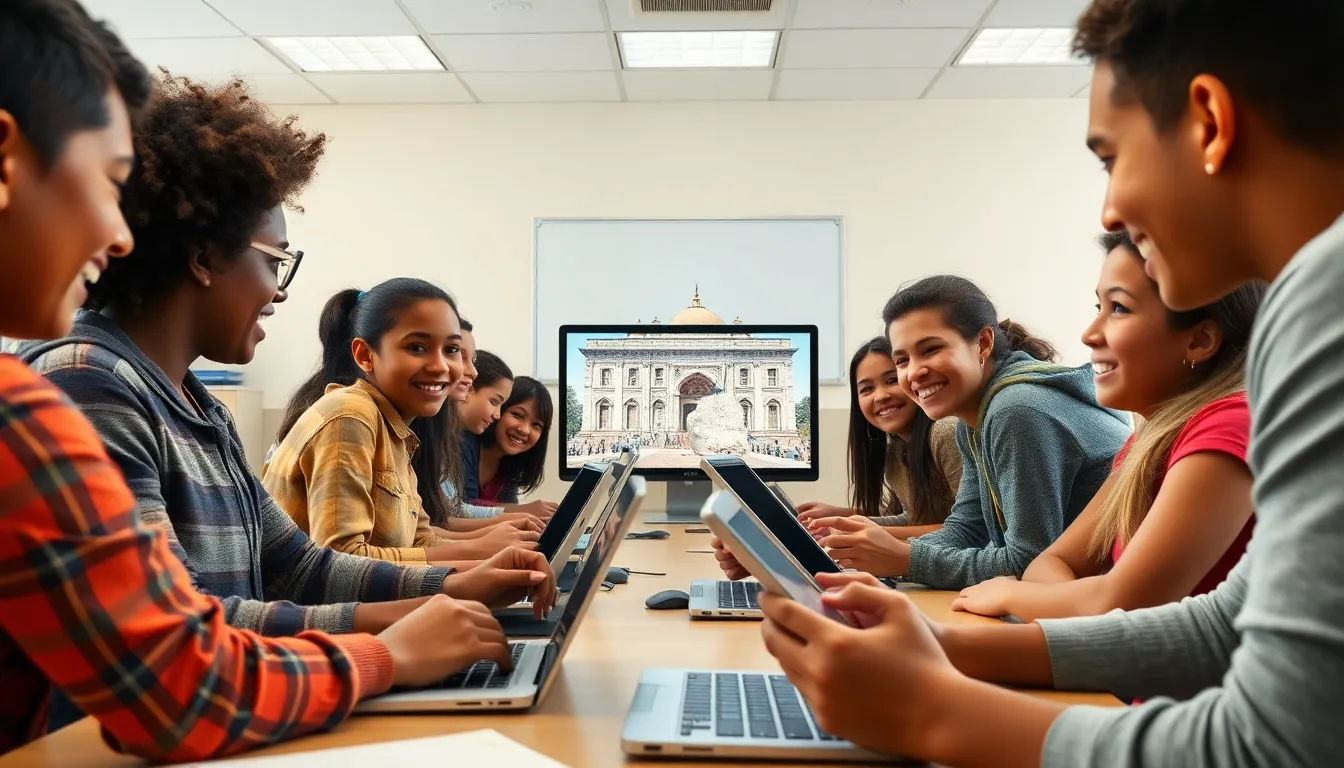Table of Contents
ToggleImagine exploring the wonders of the world without leaving your couch. Virtual field trips make that dream a reality, whisking curious minds away to museums, national parks, and historical sites—all with just a click. Gone are the days of packing snacks and enduring long bus rides; now, adventures await right on your screen.
Overview of Virtual Field Trips
Virtual field trips offer immersive experiences that allow individuals to explore locations like museums, national parks, and historical sites digitally. These trips leverage technology to create engaging learning environments without physical constraints, making travel unnecessary. Students and educators benefit significantly since lessons can be enriched through interactive elements that simulations provide.
Educational institutions recognize the importance of virtual field trips as cost-effective alternatives to traditional field trips. Many programs require minimal equipment, often just a computer or a tablet, making access straightforward. Various platforms offer curated experiences, guiding users through exhibits or presentations that showcase unique artifacts and natural wonders.
Participants gain insights into subjects that range from art history to environmental science. Interactive experiences stimulate critical thinking, enhance curriculum, and support diverse learning styles. Teachers can use virtual field trips to fulfill learning objectives while offering students novel perspectives on traditional topics.
Research indicates that students participating in virtual field trips retain information better than those relying solely on textbooks. The visual and auditory stimulation facilitates deeper understanding and memory retention. Numerous sites provide supplementary resources, reinforcing knowledge gained during the virtual tour.
Virtual field trips also promote global awareness and cultural appreciation. Users can virtually visit different countries, exposing them to various cultures, histories, and societal norms. By broadening the scope of learning, individuals develop empathy and a greater understanding of the world around them.
Benefits of Virtual Field Trips
Virtual field trips enhance learning experiences through unique advantages, making education more engaging and accessible.
Accessibility and Inclusivity
Accessibility plays a crucial role in virtual field trips. Locations that might be physically unreachable become available to all. Students with disabilities find opportunities to participate in ways that traditional trips might exclude them. Geographic barriers no longer hinder exploring international cultures or important historical sites. Materials often come in multiple formats, supporting diverse learning needs. Cost-effectiveness enhances accessibility as expenses decrease, encouraging more schools and families to engage. Inclusivity fosters a sense of community and shared experiences among participants. Virtual platforms enable real-time interactions, allowing students to connect regardless of their location.
Educational Engagement
Educational engagement improves significantly through virtual field trips. Interactive elements captivate attention, making subjects come alive. Virtual experiences stimulate curiosity and critical thinking, promoting deeper understanding of topics. Students actively learn while participating in guided tours and discussions. Teachers can tailor virtual trips to fit specific curriculum goals. Engaging visual content enhances retention rates among learners. Research indicates that participants often outperform peers who use traditional methods. By integrating technology in lessons, educators create dynamic learning environments that appeal to various learning styles and preferences.
Types of Virtual Field Trips
Virtual field trips provide diverse opportunities for education across various subjects. Each type offers unique experiences that enhance learning in different ways.
Museums and Historical Sites
Educational engagement thrives within virtual museum and historical site tours. Participants can explore world-renowned institutions, such as the Louvre and the Smithsonian, without leaving their homes. Interactive features allow visitors to zoom in on artifacts, read detailed descriptions, and access expert commentary. By integrating multimedia resources, these tours foster deeper understanding of historical contexts. Engaging narratives often animate exhibits, captivating audiences and making history feel alive. Virtual platforms frequently include live guides who answer questions in real-time, enhancing the immersive experience.
Nature and Science Experiences
Nature and science virtual field trips offer immersive exploration of ecosystems and scientific phenomena. Students can virtually visit national parks, such as Yellowstone or the Grand Canyon, observing wildlife and geological features. Live-streamed sessions with field experts allow for real-time discussions and demonstrations. These experiences deepen understanding of environmental science and conservation efforts. Additionally, hands-on activities, like virtual experiments or guided observations, promote active learning. Multimedia presentations enrich the experience by showcasing high-definition visuals and interactive elements that stimulate curiosity about the natural world.
Cultural and Art Exploration
Cultural and art exploration virtual field trips immerse participants in diverse artistic expressions and traditions. Users can attend online performances, such as theater and musical shows, or visit art installations worldwide. Immersive art experiences allow users to appreciate cultural heritage through virtual galleries and live-streamed events. Engaging narratives often guide visitors through the significance of various art forms, enhancing appreciation for cultural nuances. Workshops and interactive elements encourage creativity, allowing participants to create their own art pieces inspired by global traditions. Such experiences cultivate a deeper empathy and understanding of different cultures.
Best Practices for Implementing Virtual Field Trips
Implementing virtual field trips effectively enhances educational experiences. Best practices ensure that participants gain maximum benefits while maintaining engagement.
Preparing Students for the Experience
Preparing students involves setting clear expectations. Communicating objectives helps participants understand what they’ll explore. Familiarizing students with technology minimizes potential technical difficulties. Encouraging questions prior to the trip promotes curiosity and active participation. Providing background information enhances context, allowing students to connect what they already know with new knowledge. Engaging them in discussions about the upcoming experience creates excitement, making the event memorable.
Integrating Curriculum with Virtual Trips
Integrating curriculum with virtual trips enhances learning relevance. Aligning trips with lesson plans ensures that students achieve educational goals. For instance, math concepts can be illustrated through virtual tours of architectural sites, reinforcing real-world applications. Teachers can emphasize critical thinking skills by prompting students to analyze and reflect on what they observe. Combining these experiences with follow-up activities deepens understanding and retention. Utilizing assessments after the trip gauges learning outcomes and informs future instruction strategies.
Challenges and Limitations
Virtual field trips face several challenges and limitations that can impact their effectiveness. Technological issues often arise, including poor internet connectivity and hardware malfunctions. These problems can hinder the seamless experience expected by users. Additionally, not all students have equal access to the necessary devices or high-speed internet, creating disparities in educational opportunities.
Engagement may also suffer in virtual settings. Some students might find it difficult to participate actively compared to in-person field trips. Short attention spans can lead to diminished interaction during the trip, affecting retention of information. Educational institutions must prioritize maintaining student interest to enhance learning outcomes.
Limited sensory experiences present another challenge. Virtual trips cannot fully replicate the physical presence and sensory feedback of an actual location. Students miss out on tactile and olfactory experiences that contribute to immersive learning. This lack of real-world interaction can lead to difficulties in connecting concepts to physical environments.
Furthermore, content relevance varies across virtual offerings. Some trips may not align perfectly with specific curriculum goals or local standards. Teachers must vet options carefully to find experiences that meet educational needs without diluting essential topics.
Lastly, social interaction during virtual trips can be restricted. Students often benefit from discussions with peers and educators during in-person experiences. Identifying ways to foster interaction in digital settings remains crucial for effective group learning.
Overall, while virtual field trips provide valuable learning opportunities, they come with inherent challenges that need addressing for optimal educational impact.
Conclusion
Virtual field trips represent a transformative approach to learning that breaks down barriers and enhances educational experiences. By leveraging technology students can explore diverse locations and subjects without the constraints of traditional field trips. These immersive experiences not only foster curiosity and engagement but also cater to various learning styles, making education more inclusive.
While challenges exist such as technological limitations and potential disparities in access, the benefits of virtual field trips are undeniable. They provide opportunities for deeper understanding and global awareness, enriching students’ knowledge and empathy for different cultures. As educational institutions continue to embrace this innovative method, the future of learning looks more accessible and engaging than ever.








